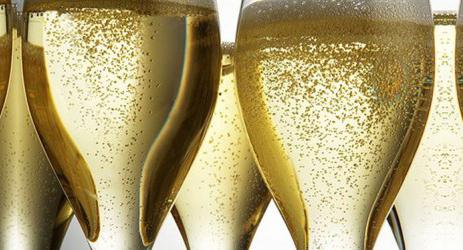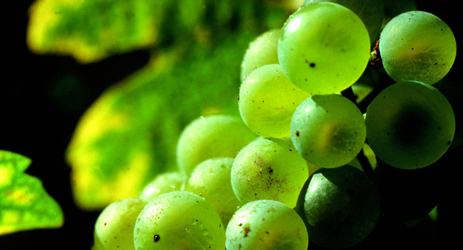Jefford on Monday
We all love a bubble. Or rather we all love the wine wrapped around those little spheres of trapped carbon dioxide: global sparkling wine consumption has gone up by 30 per cent over the past decade.
France is in the felicitous position of having 26 per cent of that world market to itself; and happier still are the Champenois, who not only account for half of all of France’s sparkling wine exports, but whose wines command by far the highest average price of any. They are not, though, the only exporters: 50 per cent all France’s sparkling wine, Crémants and others included, ends up being drunk beyond French borders.

Given that, it’s not illogical for all French winemakers, wherever they might find themselves, to consider making a little sparkling wine. Anyone could do this using basic European ‘sparkling wine’ or ‘quality sparkling wine’ legislation: the difference between the two is that ‘quality’ means slightly higher final pressure in the bottle (3.5 bars as opposed to 3) and some time spent on lees before sale (the exact amount depending on the method of bubble-acquisition). This legislation set, though, doesn’t give you the right to a regional origin.
For that, you need to have a sparkling wine appellation – at least until 2011. This situation didn’t seem fair to Vin de Pays/IGP producers, especially those who were trying to make wines which expressed terroir in some way. Let’s say you were a keen winegrower up in the département of the Yonne, for example, but happened to find yourself outside one of the 55 villages which had the right to use the Crémant de Bourgogne AOC. It’s a cool or very cool area: sparkling wine is a logical choice. So from 2011, the right to make sparkling wine was extended (under EU pressure) to IGP producers.
At that point, France’s seven Crémant-producing regions (Alsace, Bordeaux, Bourgogne, Die, Jura, Limoux and Loire) threw up their arms in horror, regarding this as ‘disloyal competition’ – a very French concept. They appealed to France’s Conseil d’Etat or Council of State, both the supreme court for questions of administrative justice, and the legal adviser to France’s lawmakers: a civil-service body of luscious and brocaded refinement. Its Council has seven divisions and nine grades (including Councillors Ordinary and Extraordinary, and Masters of Requests and Masters of Requests Extraordinary too).
Was this an Ordinary or an Extraordinary request? I’ve no idea, but 36 would-be-bubbly IGPs were hauled up before the Conseil, and last December it ruled on three of them: yes to Var, but no to Yonne and Côtes du Lot. Judgment on the others are expected any day now.

The Var request was allowed on the basis that sparkling wine-making had some ‘anteriority’ here – though I can’t understand why this didn’t count in Yonne’s favour, too, since this was a huge wine-producing département in pre-phylloxera times, as well as being a significant supplier to Champagne prior to AOC delimitation. It all depends how far back you look.
Why, though, is ‘anteriority’ even necessary? Might not innovation also weigh with the Masters of Requests and their Extraordinary brethren? Why shouldn’t a Cahors producer with vineyards high up on the cool limestone Causses make a little sparkling Côtes du Lot if he or she wants to? The wine might be just what we’re all waiting for. No one is proposing to steal the name Crémant, after all; there will be no passing off.
I understand that the Crémant producers’ anxieties spring from France’s supermarket sector, where price tends to be more important than quality, and where the lowliest priced Crémants already have to slug it out with cheap, fizzy wines produced without any of the constraints imposed on those who use the Crémant name. (This is the basis of ‘disloyal competition’: the notion will be understood by hoteliers anxious about Airbnb, or by taxi drivers fretting about Uber.)
The challenge, though, could also be an opportunity: to communicate what makes Crémants special, and to position them as an exciting alternative to Champagne combining high quality with regional style. Ambitious IGP sparkling wines would invigorate the sector further. Champagne, in truth, has been a sparkling hegemon for too long. The notion that competition is in some way bad, and that your most dangerous competitor is your neighbour, is an old-fashioned luxury which French wine producers can’t allow themselves any more.
Let’s hope that the Masters of Requests find their way to this not-very-extraordinary conclusion, and that France’s sparkling wine scene becomes more innovative, not less, in the future. 
Columnist Introduction
Andrew Jefford is a columnist for both Decanter magazine and www.decanter.com, Jefford has been writing and broadcasting about wine (as well as food, whisky, travel and perfume) since the 1980s, winning many awards – the latest for his work as a columnist. After 15 months as a senior research fellow at Adelaide University between 2009 and 2010, Andrew is currently writing a book on Australia's wine landscape and terroirs. He lives in the Languedoc, on the frontier between the Grès de Montpellier and Pic St Loup zones.
Click here to read all articles by Andrew Jefford>>
- Follow us on Weibo@Decanter醇鉴 and Facebook
and Facebook for the latest news and updates -
for the latest news and updates -
All rights reserved by Future plc. No part of this publication may be reproduced, distributed or transmitted in any form or by any means without the prior written permission of Decanter.
Only Official Media Partners (see About us) of DecanterChina.com may republish part of the content from the site without prior permission under strict Terms & Conditions. Contact china@decanter.com to learn about how to become an Official Media Partner of DecanterChina.com.




Comments
Submit